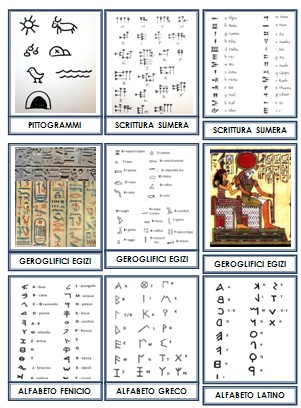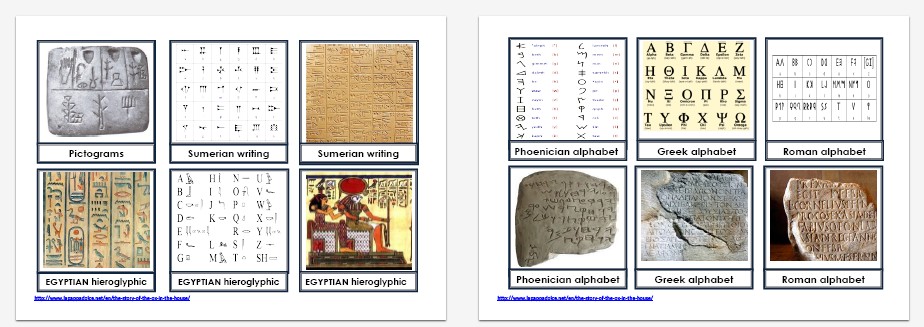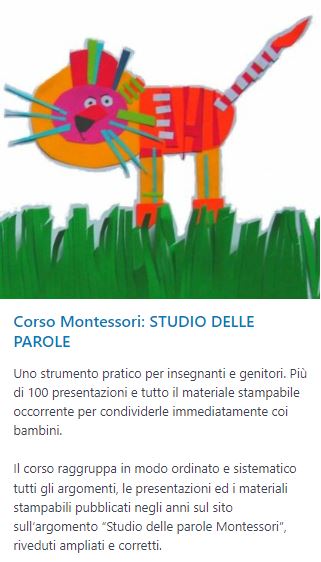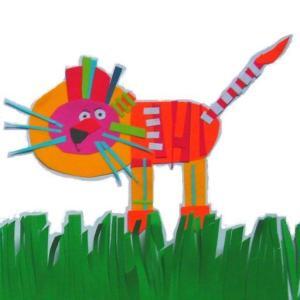LA STORIA DEL BUE IN CASA rientra nel quadro della QUARTA GRANDE LEZIONE MONTESSORI e narra della nascita della scrittura presso le civiltà del Mediterraneo.
Per avere il quadro completo della quarta grande lezione e consultare tutto l’altro materiale vai qui:
Qui trovi il racconto e le carte illustrate relative, scaricabili e stampabili in formato pdf.
LA STORIA DEL BUE IN CASA – Materiale utile per la presentazione:
Immagini:
- un’immagine che le persone avrebbero potuto usare per raccontare una storia, senza usare l’alfabeto
- tavolette sumere
- geroglifici
- alfabeto fenicio
- alfabeto greco
- alfabeto latino

LA STORIA DEL BUE IN CASA – Racconto:
Per moltissimo tempo, quando le persone volevano lasciare un messaggio agli altri, disegnavano la scena che volevano raccontare sulla pietra (mostrare la carta 1).
Poi, a Sumer, gli uomini hanno cominciato, per registrare i loro messaggi, a incidere dei segni sulla creta molle, utilizzando uno strumento appuntito chiamato stilo. Le tavolette di creta, una volta incise, venivano cotte al sole, e diventavano dure. In questo modo venivano scritti veri e propri libri, ed esistevano intere biblioteche di testi scritti con questo stile di scrittura, chiamato scrittura cuneiforme. Cuneiforme significa “a forma di cuneo”. Potete immaginare la meraviglia che provarono i primi studiosi che scoprirono questo tesoro (mostrare la carta 2).
Un altro gruppo di persone che viveva in Egitto, usava invece scolpire o dipingere dei bellissimi segni sulla pietra. Essi poi scoprirono una pianta chiamata papiro, una canna che cresce sulle sponde del fiume Nilo, ed impararono ad usarla per fabbricare dei fogli, sui quali scrivevano con un inchiostro che ricavavano dalla fuliggine, utilizzando dei pennelli (mostrare la carta 3).
Per leggere questi messaggi è necessario conoscere il significato esatto di ognuno dei disegni. Questi disegni sono chiamati geroglifici (parola che significa “scrittura sacra scolpita”). Era sacra perché pochi erano in grado di leggerla.
Nello stesso periodo esisteva un altro gruppo di uomini, i Fenici. Questo popolo viaggiava in lungo e in largo per il Mar Mediterraneo, su barche a vela, per vendere argento, gioielli, spezie, seta e porpora di Tiro, un colorante rosso molto speciale, che ricavavano da una specie particolare di mollusco, e che veniva usato per tingere i tessuti. I Fenici erano molto abili nel commercio, vendevano le loro merci, prendevano il ricavato e velocemente salpavano verso altri territori, per mettere a frutto al meglio il loro commercio. Viaggiavano continuamente, entrando così in contatto con molti popoli e molte lingue diverse. Quando incontrarono gli Egizi furono molto impressionati dalla loro scrittura, e pensarono che poteva essere molto utile disporre di un metodo per registrare le cose comprate e vendute, e poter così calcolare quanto era stato il guadagno. La scrittura degli Egizi, però, era molto complicata, e scrivere in quel modo richiedeva troppo tempo, così decisero di utilizzare un sistema più semplice e veloce. Si accorsero che gli Egizi, oltre ad usare geroglifici che simboleggiavano oggetti o idee, avevano dei geroglifici che rappresentavano soltanto suoni, i suoni prodotti mentre si pronunciano le parole. Pensarono così che sarebbero bastati una ventina di questi segni per avere a disposizione tutti i suoni, e quindi poter scrivere tutte le parole. I segni che usarono i Fenici per scrivere somigliavano ad oggetti d’uso quotidiano (mostrare la carta 4).
Qui possiamo vedere i loro primi due segni. Il primo si presenta come la testa di un bue, e rappresenta il suono “Aleph”. Il secondo sembra una casa, e rappresenta il suono “Beth”.
Anche agli antichi Greci l’idea dei Fenici piacque molto, ed anch’essi vollero usarla per scrivere le cose che ritenevano importante registrare. Rinunciarono a far somigliare le loro lettere a buoi o a case, e le lettere cominciarono ad assumere un aspetto diverso (mostrare la carta 5).
Queste sono le prime due lettere hanno usato: sono ”Alpha’ e “Beta”, le prime due lettere dell’Alphabeta, parola greca che significa appunto alfabeto. I Greci usavano le lettere per scrivere testi poetici e teatrali, e per registrare le proprie idee sulla vita.
I Romani, che vennero dopo i Greci, pensarono anch’essi che un alfabeto fosse davvero molto utile: si poteva usare per scrivere i progetti per costruire le strade, per inviare messaggi nei territori lontani, per coordinare il lavoro di tutti i soldati e i governatori del vasto territorio che controllavano. Poiché i Romani amavano anche scrivere messaggi sui monumenti e sugli edifici che costruirono, semplificarono molto le lettere, in modo che fossero facili e veloci da scrivere (mostrare la carta 6).
Così, i segni inventati dai Fenici sono stati utilizzati da molti uomini e si diffusero in tutto il mondo, fino ad arrivare a noi. Sono gli stessi delle nostre lettere smerigliate.
Quando impariamo a conoscere le lettere che compongono l’alfabeto, possiamo scrivere le nostre idee e dire agli altri ciò che pensiamo. Possiamo leggere messaggi scritti da persone che non abbiamo mai incontrato, che vivono dall’altra parte del mondo, o che sono vissuti nel passato.
Possiamo inviare messaggi ai nostri amici mentre siamo in vacanza, o scrivere biglietti d’auguri per augurare loro un buon compleanno.
Anche se l’invenzione dell’alfabeto è avvenuta molto tempo fa, l’ho usata per raccontare questa storia a voi, oggi!
LA STORIA DEL BUE IN CASA

THE STORY OF THE OX IN THE HOUSE is part of the FOURTH GREAT MONTESSORI LESSON and tells of the birth of writing in the Mediterranean civilizations.
Here is the story and picture cards related, downloadable and printable for free in pdf format.
THE STORY OF THE OX IN THE HOUSE
Useful material for the presentation:
Pictures:
- an image that people could use to tell a story without using the alphabet
- Sumerian tablet
- hieroglyphs
- Phoenician alphabet
- greek alphabet
- Roman alphabet

THE STORY OF THE OX IN THE HOUSE
Story:
For a very long time, when people wanted to leave a message to others, they drew the scene who wanted to tell on the stone (show the card 1).
Then, in Sumer, the men began for recording their messages, to engrave marks on soft clay, using a sharp tool called stylus. The clay tablets, once recorded, were cooked in the sun, and became hard. In this way they were written real books, and there were entire libraries of texts written in this style of writing, called cuneiform writing. Cuneiform means “wedge-shaped”. You can imagine the wonder that the first scientists who discovered this treasure felt (show the card 2 and the card 3).
Another group of people who lived in Egypt, used instead to carve or paint some beautiful marks on the stone. They then discovered a plant called papyrus, a reed that grows on the banks of the Nile River, and learned to use it to manufacture sheets, on which they wrote with an ink that took from the soot, using brushes (show card 4, card 5 and card 6).
To read these messages you must know the exact meaning of each drawings. These drawings are called hieroglyphics (a word that means “sacred writing carved”). It was sacred because few people were able to read it.
In the same period there was another group of people, the Phoenicians. This people traveling the length and breadth of the Mediterranean Sea, on sailboats, to sell silver jewelry, spices, silk and Tyrian purple, a very special red dye, which they extracted from a particular species of mollusk, and thatwas used to dye fabrics. The Phoenicians were very skilled in the trade, they were selling their goods, they took the money and quickly sailed towards other territories, to build on the best of their trade.
They are traveling constantly, thus entering into contact with many people and many different languages. When they met the Egyptians were very impressed by their writing, and thought it could be very useful to have a method for recording the things bought and sold, and be able to calculate how much was the gain.
The writing of the Egyptians, however, was very complicated, and write in that way required too much time, so they decided to use a simpler and faster system. They realized that the Egyptians, as well as using hieroglyphs that symbolized objects or ideas, they had hieroglyphics representing only sounds, the sounds produced while the words are pronounced. So they thought that would have been enough twenty of these signs to have all the sounds, and then be able to write all the words. The signs that the Phoenicians used to write were like everyday objects (show the card 7).
Here we can see their first two signs. The first looks like the head of an ox, and it represents the sound “Aleph”. The second feels like a home, and it represents the sound “Beth”.
Even the ancient Greeks really liked the idea of the Phoenicians, and also wanted to use it to write down things they considered important to record. They gave up to look like their letters to oxen or homes, and letters began to take on a different look (show the card 8).
These are the first two letters that they used: they are ” Alpha ‘and’ Beta ‘, the first two letters dell’Alphabeta, a Greek word which means alphabet. The Greeks used the letters to write poems and plays, and to record their ideas on life.
The Romans, who came after the Greeks, they too thought that an alphabet was indeed very useful: it could be used to write projects to build roads, to send messages to distant lands, to coordinate the work of all the soldiers and governors of the vast territory they controlled. Because the Romans also loved to write messages on the monuments and buildings that they built, they simplified a lot the letters, so that they were quick and easy to write (show card 9).
Thus, the signs invented by the Phoenicians have been used by many people and spread around the world, up to us. They are the same as our movable alphabets.
When we learn the letters of the alphabet, we can write our ideas and tell others what we think. We can read messages written by people who have never met, who live halfway around the world, or who have lived in the past. We can send messages to our friends while we’re on vacation, or write greeting cards to wish them a happy birthday.
Even if the invention of the alphabet was made a long time ago, I used it to tell this story to you… today!


